#william shayer
Text
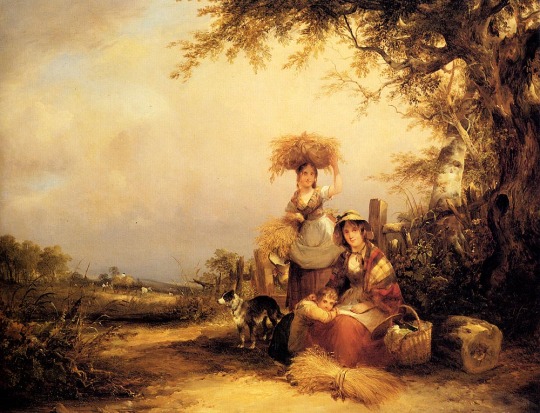
The Gleaners Shirley, Hants painted by William Shayer (1788 - 1879)
#art#art history#artwork#culture#curators#history#museums#painting#romanticism#vintage#william shayer
62 notes
·
View notes
Text

William Shayer (1787-1879)
Figures resting outside a cottage
Signed W Shayer Senr (lower left)
Oil on canvas
Woolley and Wallis
4 notes
·
View notes
Photo
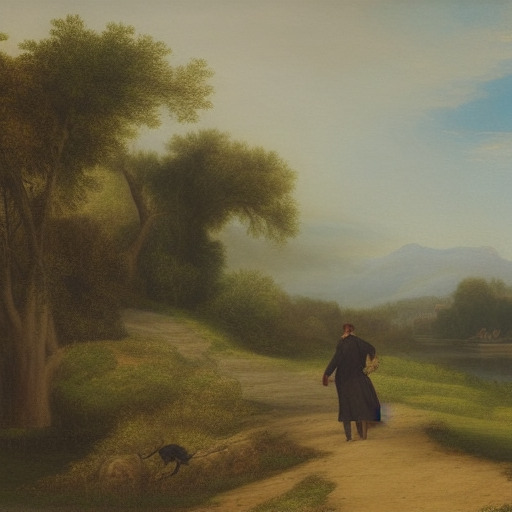
romanticism painting of a man follows a well trodden path, from which one can look over the river and see the town by william shayer
0 notes
Photo

William Shayer (1787-1879), British genre and heraldic painter. Exh. RA, the Society of British Artists, etc.
South Coast Fisher Folk, undated, oil on canvas (private collection, via Leighton Fine Art).
1 note
·
View note
Photo
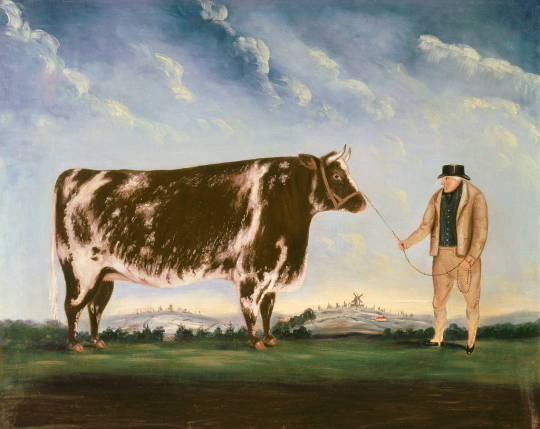
Study of a Shorthorn
by William Joseph Shayer
Iona Antiques, London, UK
2 notes
·
View notes
Photo

William Shayer: La casa a mitad de camino, Thatcham (1848).
2 notes
·
View notes
Text
Conversação

Arte: Conversation in a Glade is a painting by William Shayer
Nas últimas horas os internautas ficaram estarrecidos com a notícia de que o ator Will Smith deu um “socão no beiço” de um humorista (era humorista? Nem sei quem é ele... mas enfim.). É como se a população do mundo tivesse ganhado um novo entretenimento para afastar o tédio.
Aliás, não é preciso ser um gênio para concluir que há cerca de 99,9% de chances daquilo tudo ter sido invenção para atrair as pessoas, visto que poucas pessoas estavam interessadas no evento de premiação (era um evento de premiação? Meu Deus! Como estou desatualizado!)
Mas isso me levou à uma reflexão. É assustador em como as pessoas passaram a ficar dependentes de assuntos para divulgar e debater nas redes sociais, como se a vida delas dependesse exclusivamente disso. É o famoso “Pão e Circo”. As pessoas podem estar tendo sua Liberdade confiscada, mas se distraindo com pão e circo elas nem irão perceber.
Na noite de ontem fui comprar algo para jantar e me apavorei com a seguinte situação: as pessoas que encontrei no estabelecimento estavam conversando apenas sobre o que está na moda! As mesmas notícias que vejo na TV e nas redes sociais o tempo inteiro. Diga-me: Isso não se parece com a perda da capacidade de pensar por si mesmo – de refletir sobre assuntos realmente relevantes?
E isso me levou a uma outra reflexão. Nesse mundo pós-moderno, onde estamos constantemente conectados com tudo o tempo inteiro, aumento o número de casos de ansiedade, de depressão e suicídio. Mas oras, o que leva a pessoas a estarem cada vez mais desanimadas com a vida? Seria o fato de elas estarem se preocupando com coisas banais e que não vão mudar em nada a vida delas? Aposto que essas pessoas seriam mais felizes se elas começassem a filtrar quais notícias são de fato relevantes e quais são inúteis para a vida delas.
É importante que tenha-se a conscientização de que o fato de um ator dar um “socão no beiço” de um outro alguém não vai mudar em absolutamente nada a vida das pessoas e que, por outro lado, um passeio no parque sem o celular tem um impacto significativo. Veja: não é porque uma música está em 1º lugar nas paradas que ela é uma música de qualidade – e muitas músicas, inclusive, tem a capacidade de arruinar o psicológico delas. Portanto, não há necessidade de sermos dependentes da elite global que nos diz o que devemos falar e ouvir. Aliás, experimente tirar um tempinho para ouvir músicas que nunca tocaram na rádio e veja a mágica acontecer.
Começar a pensar por si mesmo, dando pouca importância para o que acontece em Hollywood, na Disney, na Rede Globo, e começar a focar mais nas situações presentes no dia a dia. Ao invés de ouvir notícias, ouça seu filho/sua filha conversando, ouço o som de pássaros cantando, e veremos uma mágica acontecer: o número de pessoas felizes irá aumentar.
2 notes
·
View notes
Photo

HMS Alexander, a 74-gun third-rate ,shortly before striking her colours to the French squadron, 6 November 1794, by William Shayer 1819
On 13 March 1780, Alexander and HMS Courageaux captured the 40-gun French privateer Monsieur after a long chase and some exchange of fire. The Royal Navy took the privateer into service as HMS Monsieur.
In 1794, whilst returning to England in the company of HMS Canada after escorting a convoy to Spain, Alexander, under the command of Rear-Admiral Richard Rodney Bligh, fell in with a French squadron of five 74-gun ships, and three frigates, led by Joseph-Marie Nielly. In the Action of 6 November 1794 Alexander was overrun by the Droits de l'Homme, but escaped when she damaged the Droits de l'Homme’s rigging. Alexander was then caught by Marat, which came behind her stern and raked her. Then, the 74 gun third-rate Jean Bart closed in and fired broadsides at close range, forcing Bligh to surrender Alexander. In the meantime, Canada escaped. The subsequent court martial honourably acquitted Bligh of any blame for the loss of his ship.
The French took her to Brest and then into their French Navy under the name Alexandre. On 22 June 1795, she was with a French fleet off Belle Île when the Channel Fleet under Lord Bridport discovered them. The British ships chased the French fleet, and brought them to action in the Battle of Groix. During the battle HMS Sans Pareil and HMS Colossus recaptured Alexander. After the battle, HMS Révolutionnaire towed her back to Plymouth.
She took part in the Battle of the Nile in 1798, under the command of Captain Alexander Ball. She was the second ship to fire upon the French fleet, engaging the flagship, L'Orient. The Alexander sank three French ships before she had to withdraw due to a small fire on board. The Alexander was one of the few ships not carrying a detachment of soldiers.Northumberland, Alexander, Penelope, Bonne Citoyenne, and the brig Vincejo shared in the proceeds of the French polacca Vengeance, captured entering Valletta, Malta on 6 April.Alexander served in the navy’s Egyptian campaign between 8 March 1801 and 2 September, which qualified her officers and crew for the clasp “Egypt” to the Naval General Service Medal that the Admiralty issued in 1847 to all surviving claimants.
51 notes
·
View notes
Text



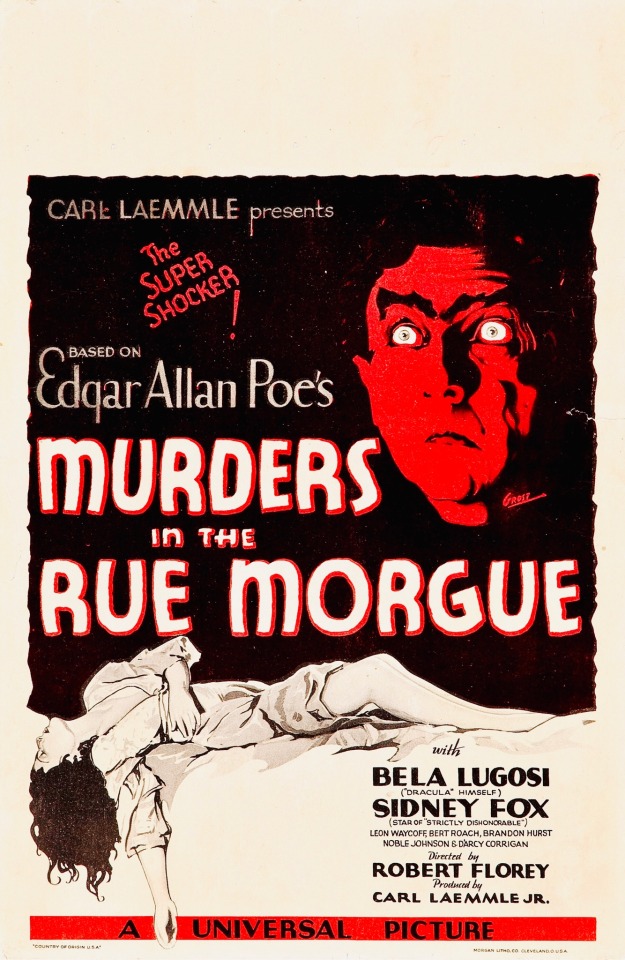
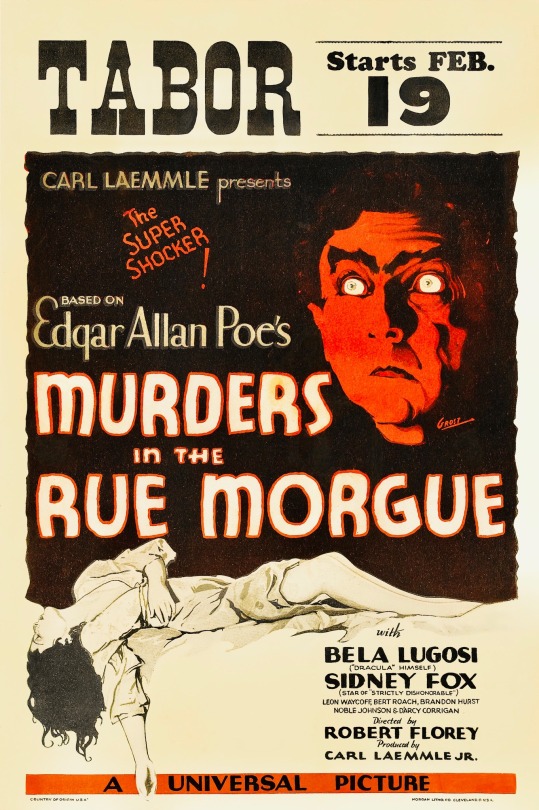

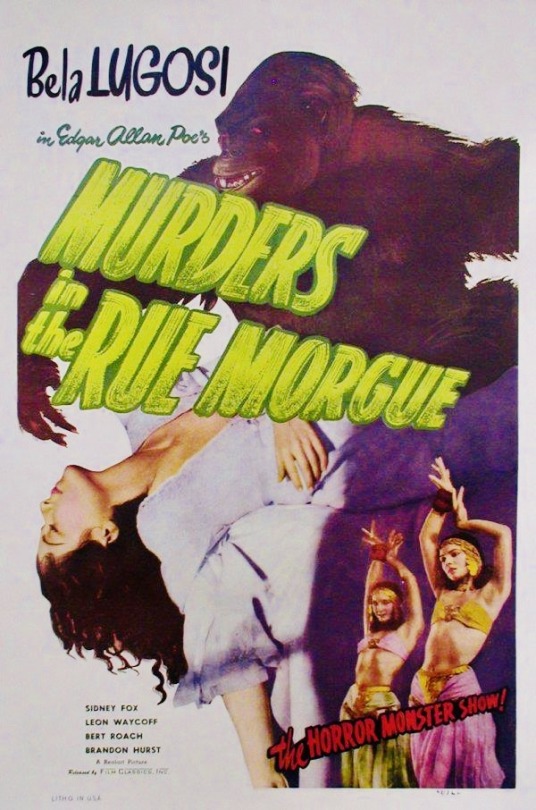



1932
Il Dottor Miracolo Murders In The Rue Morgue (Universal Studios, 1932)
Producer: Carl Laemlle, Jr.
Associate Producer: E.M. Asher
Director: Robert Florey
Assistant Directors: Scott Beal, Joseph McDonough and Charles Gould
Screenplay: Ron Reed and Dale Van Every
Original Story: Edgar Allan Poe
Adaptation: Robert Florey
Additional Dialogue: John Huston
Scenario Editor: Richard Shayer
Art Director: Charles D. Hall
Set Designer: Herman Rosse
Recording Supervisor: C. Roy Hunter
Cinematography: Karl Freund
Editor: Milton Carruth
Supervising Film Editor: Maurice Pivar
Special Effects: John P. Fulton
Special Process: Frank D. Williams
Music Direction: Heinz Roemheld
Make-up: Jack P. Pierce
Technical Adviser: Howard Salemson
Running Time: 62 minutes
Copyright Number: LP2804, January 27 1932
Cast:
Sidney Fox: Mlle. Camille L’Espanaye
Bela Lugosi: Doctor Mirakle
Leon Waycoff: Piere Dupin
Bert Roach: Paul
Brandon Hurst: Prefect of Police
Noble Johnson: Janos, The Black One
D’Arcy Corrigan: Morgue keeper
Betty Ross Clarke: Mme. L’Espanaye
Arlene Francis: Woman of the streets
Edna Marion: Mignette
Charlotte Henry: Girl
Polly Ann Young: Girl
Herman Bing: Franz Odenheimer
Agostino Borgato: Alberto Montani
Harry Holman: Victor Albert Adolph Jules Hugo Louis Dupont, the landlord
Torben Meyer: The Dane
John T. Murray: Gendarme
Dorothy Vernon: Tenant
Christian J. Frank: Gendarme
Michael Visaroff: Mirakle’s sideshow barker
Ted Billings: Sideshow spectator
Charles T. Millsfield: Bearded man at the sideshow
Monte Montague: Workman/Gendarme
Charles Gemora: Erik the ape
Joe Bonomo: Stunt double for Charles Gemora
Harrison Green: Sideshow barker
Tempe Pigott: Crone
Iron Eyes Cody: Indian at sideshow
Charlotte Henry: Sideshow spectator
#il dottor miracolo#murders in the rue morgue#bela lugosi#edgar allan poe#horror movies#film horror#horrormovies#gothic horror#horror film#horrormovie#giallo fever#giallofever#italian cult#cult#cinema cult#italian giallo#italian sexy comedy#international cult#gialli#giallo
4 notes
·
View notes
Text
Check out this item in my Etsy shop https://www.etsy.com/uk/listing/665073397/antique-19th-century-gilt-framed-oil
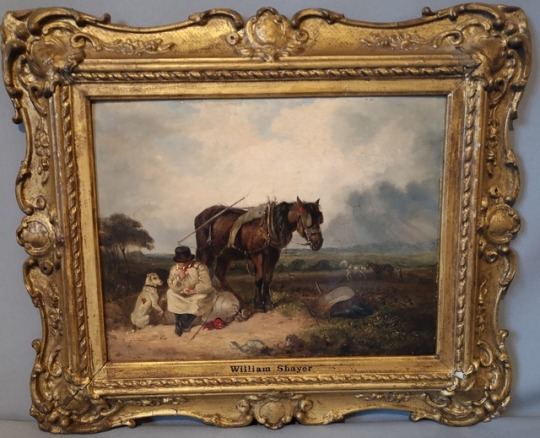
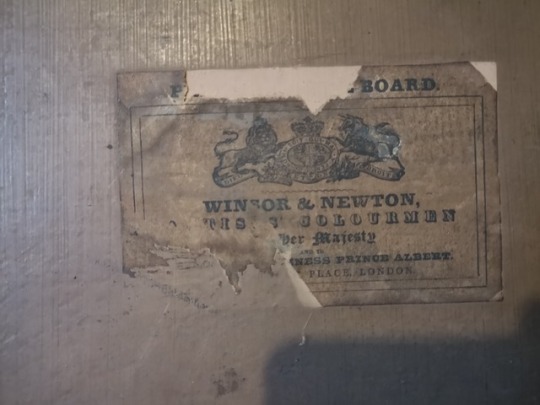
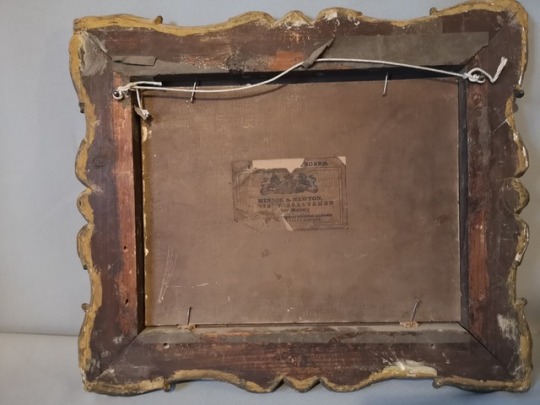
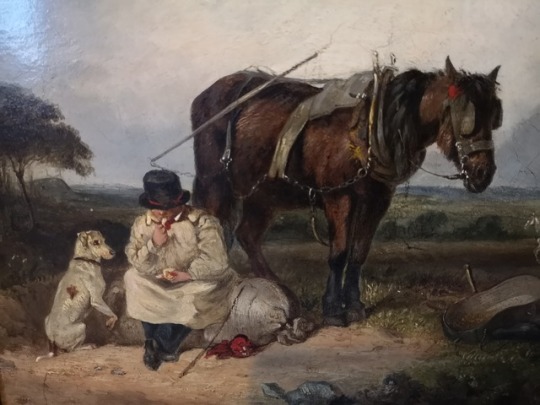

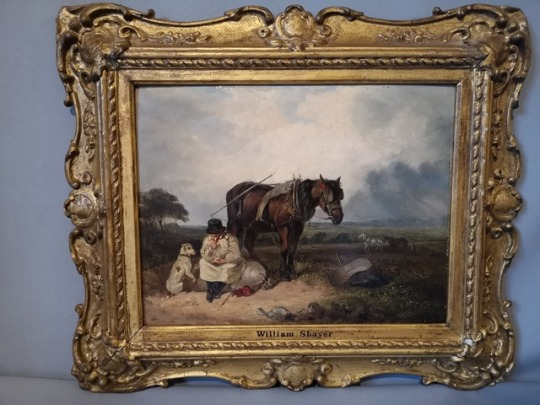




#WilliamShayer#Antiqueoilpainting#EnglishMasters#signed oil painting#signed#ws#William Shayer#antique oil painting#antique oil paintings#Signed Original#horse#dog#victorian oil painting#oil painting#painting#antique paintings#horse painting#dog painting#landscape painting#antique landscape painting
0 notes
Text
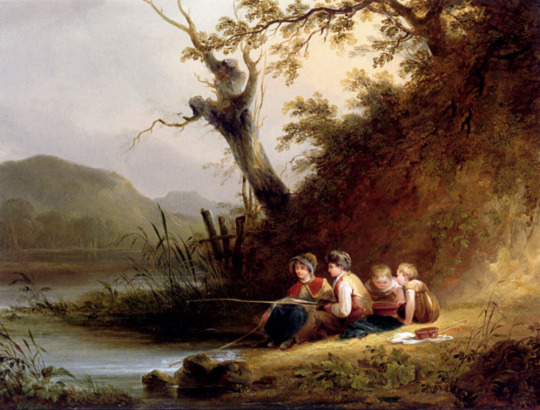
The Young Anglers painted by William Shayer (1788 - 1879)
#art history#painting#art#artwork#museums#history#culture#vintage#curators#william shayer#romanticism
62 notes
·
View notes
Text
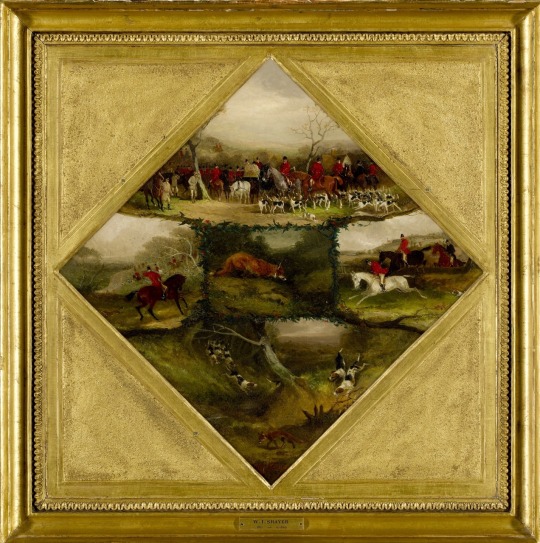
WILLIAM JOSEPH SHAYER
British
1811 - 1892
FOXHUNTING VIGNETTES
signed W.J. Shayer and dated 1870 (lower center)
oil on panel, diamond-shaped
Sotheby's
2 notes
·
View notes
Video
William Shayer Senior - landscape painter and figure painter
0 notes
Text
Tunnel and Cave Symbolism
In symbolism, there is often a manmade and naturally occurring equivalent. The tunnel is the manmade version of a cave, the sewer a sea cave.
In symbolism, there is often a manmade and naturally occurring equivalent. The tunnel is the manmade version of a cave, the sewer a sea cave.
Other examples:
The pool is the manmade equivalent of a pond. This symbolism is utilised by Helen Simpson in her short story “Up At A Villa“.
The atrium is the manmade equivalent of Heaven / sky.
The cathedral is a manmade attempt at a forest.
The cauldr…
View On WordPress
0 notes
Video
vimeo
Fires - Life is Better Blonde from Natalie Erika James on Vimeo.
Consumed by a virtual reality set in a reimagined 1950s, a player’s longing for motherhood transcends the rules of the game.
Directed by Natalie Erika James - nejames.com & Ben Morgan
Produced by Emma Haarburger & Logan Davies
Best Cinematography at SoundKILDA, St Kilda Film Festival
CLIPPED Music Video Festival, VIVID Sydney, 2017
Hollyshorts Film Festival, 2017
Szczecin European Film Festival, 2017
Woodengate Film Festival, 2017
Bucharest Shortcut Cinefest, 2017
- Best Music Video
- Best Cinematography
Byron Bay International Film Festival, 2017
Production Company: Fiction Film Company – fiction.net.au
Starring: Jem Nicholas, Emi Canavan, Elias Nixon-Luke, Ashlee Anne Scotland
Cinematographer: Charlie Sarroff – charliesarroff.com
Camera Operator: Hugh Turral
Production Designer: Maddie Latomanski
Wardrobe: Sophie Woodward
1st AD: Baris Ulusoy, Tomas Zagoda
1st AC: Nick Forster
2nd AC: Aydin Bozkurt, Rainer Kelly
Gaffer: Guillermo Perez-Pedraza
Best Boy: William Thomson, Tom Ohehir, Hudson Sowada
Hair & Makeup / SFX Makeup: Lou McLaren
Art Department Assistants: Nikita Dunovits-Ferrier, Sasha Heath, Liv Bunting
Wardrobe Assistant: Sabine Battel
VR Glasses Designer: Jake Robb
3D Printer: Thing Lab
SFX Supervisor: John Sanderson
SFX Assistant: Sam Deal
Stunt Coordinator: Warwick Sandler
Stunt Double: Kate Angus
Stunt Assistant: Jade Amantea, Hayden Stewart, James McCready
Safety Supervisor: Danny Woodrow
Paramedic: Robert Gorman
VFX: Louis Nikolovski
Editor: Natalie Erika James, Benjamin Morgan
Colourist: Chris Reynolds – Retrobox – retrobox.com.au
Production Assistants: Carla Giurleo, Bianca Perillo
Stills: Robert Geary
BTS Videographer: Callum Harrison, Irany Turral
Nannybot: Jem Nicholas
VR Gamer: Emi Canavan
Baby: Elias Nixon Luke
Stranger Nannybot: Ashlee Anne Scotland
Thanks: Stephen James, Sasha Heath, Darcy Prendergast, Florence Holmes, Truce Films, Alexander Brown, Guy & Rachel Nixon Luke, Olivia Townsend, Tom Ohehir, Rob and Anne-Marie Hanson
Special Thanks:
The Estate of the Late Werner Haarburger and the Haarburger Family
Shayer Group, Pentridge Prison - pentridgecoburg.com.au
0 notes
Text
NEW CREATORS AT ABT
The program on Wednesday, October 23, comprised ballets by one recent and two new dance makers for the company, and the dancers seemed energized by the spirit and the rigor of the new works. There are no radical departures in form, but these younger choreographers have a feel for what the dancers are technically capable of and don’t hesitate to exploit their strengths.
The company’s initiative to promote women dance makers has changed the power dynamics onstage and fostered more of a balance of control in the dancing. Yes, the women still get lifted and supported by men, but they’re no longer passively compliant. Sometimes they ask for what they want and get it. With this current initiative to increase both the racial diversity and the pool of women choreographers in ballet, there seems to be a welcome generational shift to greater equality of control for ballerinas.
As if to prove the point, the program opens with James Whiteside’s debut ballet for the company, featuring a high-powered cast – Calvin Royal III (African-American), Joo Won Ahn (Asian), Aran Bell, Devon Teuscher, Catherine Hurlin, Isadora Loyola, Katherine Williams, and Stephanie Williams. “New American Romance,” is set to “Suite Bergamasque” for piano solo by Claude Debussy, played flawlessly by Jacek Mysinski, live.

James Whiteside’s NEW AMERICAN ROMANCE. (center) Aran Bell, (clockwise from top right) Calvin Royal III, Isadora Loyola, Stephanie Williams, Devon Teuscher, Catherine Hurlin, Katherine Williams, and Joo Won Ahn. photo by Rosalie O’Connor
The work – nicely organized into four movements separated by blackouts – is a look at the choreographer’s unique take on romantic love, one that steers clear of Hollywood sentimentality. A duet for Catherine Hurlin and Aran Bell – the closest thing to a traditional “romantic” pas de deux – demands total trust with spectacular lifts that literally flip Hurlin repeatedly and surprisingly over Bell’s powerful arms and climaxes in a risky, one-handed overhead press. No saccharine love affair this!
Katherine Williams, Isadora Loyola, and Stephanie Williams are best buds, tipping on their pointes in mutual support, copying each other’s motifs in canon, and shimmying their shoulders in liberated defiance. Whiteside underlines the women’s power by having Katherine Williams do a chain of entrechats and all three, tours to the knee, which they pull off without batting an eye.
Movement Three introduces romantic gender diversity, when, after starting as a lovey-dovey duet for Teuscher and Ahn, it veers into the unexpected, when Royal enters and becomes the object of both their affections. They end up with their bodies draped atop of each other in a discreetly passionate threesome.
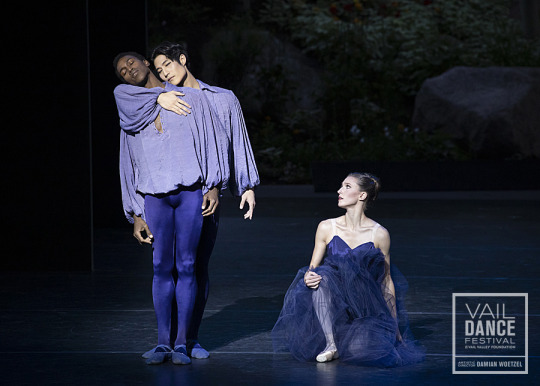
(l-r): Calvin Royal III, Joo Won Ahn, and Devon Teuscher in James Whiteside’s NEW AMERICAN ROMANCE photo by Erin Baiano
Brandon Stirling Baker bathes the piece in washes of cool light, and costumes provided by Primadonna are sweetly romantic, long, blue tutus on the women and blousy, light blue shirts and dark tights for the men, accentuating the irony of Whiteside’s wry deconstruction of traditional romance. It’s a structurally clear and teasingly inventive debut that promises more to come.
Gemma Bond’s world premiere, “A Time There Was” draws its moods from Benjamin Britten’s acerbic “Suite on English Folk Songs” – whence the title – and his “Fugue and Variations on a Theme of Frank Bridge.” David LaMarche conducts with his customary brio. Sylvie Rood’s costumes are body-hugging but ornate bodices that suggest Renaissance attire; sleeves get added for some of the women and skirts made of streamers for some of the men. Serena Wong is the lighting designer, starting the piece dramatically by silhouetting the cast of fifteen against the cyclorama.
The ballet is divided into five sections that each feature a different couple with background attendants – Cassandra Trenary and Cory Stearns, Katherine Williams and Tyler Maloney, Zimmi Coker and Gabe Stone Shayer, Stearns and Teuscher, finally Isabella Boylston and Whiteside. The action whizzes by, dense and fast-paced, so distinctions among the characters are a matter for later reflection. A slow tempo passage generally greets the entrance of each subsequent featured couple, but the texture of the dancing throughout is similar, making it hard to parse in a single viewing.
But the movement has a youthful exuberance and freshness, and the costumes liven the space with changing color palettes, as dancers rush on and offstage. The final ”Fugue and Finale,” features Boylston partnered by Whiteside and brings the ballet to a quiet, pensive close, with them drifting offstage together.

(l-r): James Whiteside and Isabella Boylston in Gemma Bond’s A TIME THERE WAS. photo by Rosalie O’Connor
I imagine Jessica Lang’s “Garden Blue” (2018) to be set in a bright garden, saturated in Nicole Pearce’s sunny lighting. But although bright colors predominate in the costumes, none is actually blue. The three couples wear sleek unitards in electric colors; Aran Bell and Catherine Hurlin in red/orange, Thomas Forster and Brittany Degrofft in canary yellow, and Blaine Hoven and Skylar Brandt in fuchsia; the fourth woman, Hee Seo’s unitard is white with green patches.
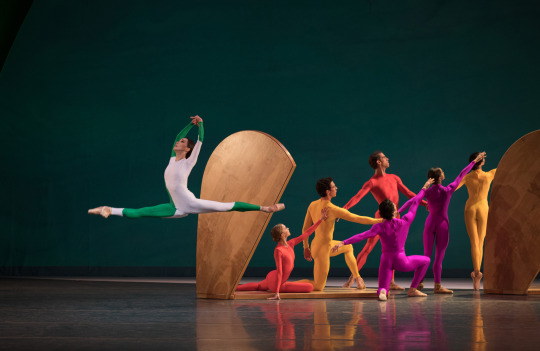
(l-r): Hee Seo with Catherine Hurlin, Thomas Forster, Blaine Hoven, Aran Bell, Skylar Brandt, and Brittany DeGrofft in Jessica Lang’s GARDEN BLUE. photo by Rosalie O’Connor
The costumes are by Sarah Crowner, as is the setting, which consists of three sturdy wooden forms that look like the whirlybirds that fall from maple trees; two are onstage and a third, hangs above. The music is the first three movements of Antonin Dvořák’s “Piano Trio No. 4 in E Minor.” Dancers’ repeated tiny flutters of arms suggest insects’ wings. The dancers rearrange the set pieces throughout, sheltering and concealing dancers, and reshaping the space. Seo flits about like the boss of the six, making things happen. Lang’s ballet like the other two are welcome, lyrical additions to the ABT repertory.
Gus Solomons jr, © 2019
0 notes